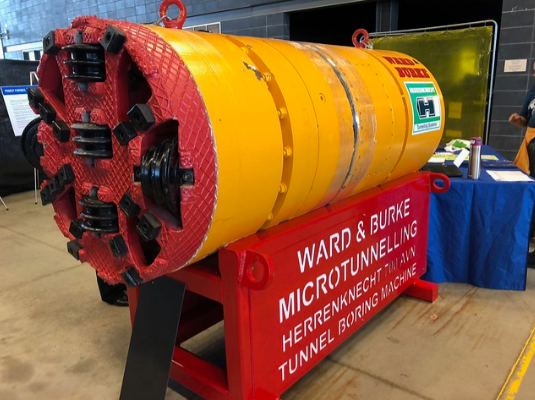Steve Pawlett
Special to Ontario Construction News
York Region has been recognized with the Peter J. Marshall Innovation Award for its York Durham sewage system forcemain twinning project, construction that broke records by using innovative microtunneling technology to reduce public and environmental disruptions.
The project included construction of two of the longest curved microtunnel drives in North America, measuring 820 metres and 1,132 metres. In less than a year, the project team successfully completed all eight micro-tunnelling drives, including installation of carrier pipe and construction of chambers.
Microtunnelling technology relies on a laser-guided boring machine controlled remotely by an above-ground operator. It minimizes road or land access closures, reduces the need to excavate and backfill, and reduces the size and number of construction sites. The technology was used to tunnel seven different stretches for a total of 5.6 kilometres, making it one of the longest micro tunnel projects in Canada’s history.
“Microtunneling technology offers several advantages in terms of the final product, as well as minimal impacts to the community and natural environment,” explains Mike Rabeau, director, public works capital planning and delivery at York Region.
“It produces a straighter and smoother alignment with fewer fittings and bends by using the two-pass system (where the forcemain is grouted and secured in place within the micro tunnel). This approach extends the design life of a sewage forcemain and reduces the need for rehabilitation works for many years into the future.”
Rabeau adds, “microtunneling is ideal for crossing rivers, roads and railway lines that would be encountered along the alignment as it minimizes impacts to the groundwater table and associated impacts to the natural environment, as it does not require dewatering.”
The innovative technique minimizes surface disruption compared to open-cut construction, including road or lane closures, which reduces traffic impacts.
“By minimizing the need to excavate and backfill, it produces less waste soils and reduces trucking requirements resulting in direct GHG emissions reductions and reduced community traffic, noise and dust pollution,” says Rabeau.
“Effective and proactive communication and public engagement to inform and actively engage our municipal partners, residents, stakeholders, elected officials before, during and after construction also contributed to the project’s overall success.”
When comparing just the excavation requirements of microtunneling and open-cut methodologies for a project of this size and depth, the excavated material produced by micro tunnelling is approximately two-thirds less than the open-cut methodology.
York Region elected to twin the existing sewage system forcemain in the Town of Newmarket to provide redundancy for aging infrastructure, improve system reliability and reduce environmental risk. The project also increases capacity for growth.
The technology was beneficial for this pipeline because it travels along highly urbanized areas, rail lines and underwater courses. York Region worked with partners at the Town of Newmarket and the Lake Simcoe Region Conservation Authority and engaged with elected officials and the public throughout the project. Infrastructure Canada supported the project by providing $48 million in funding through the Disaster Mitigation and Adaptation Fund (DMAF), recognizing this project’s role in addressing climate-related risks.
The P.J. Marshall Award is an annual competitive process to acknowledge municipalities who have had creativity and success in implementing new, innovative ways of serving the public. The award ceremony was held at the Association of Municipalities of Ontario conference in Ottawa last month.
“On behalf of York Regional Council and The Regional Municipality of York, we are honoured to accept the Association of Municipalities Ontario’s P.J. Marshall Award,” York Region Chairman and CEO Wayne Emmerson said.
“Using state-of-the-art, record-setting microtunneling design and construction, York Region was able to minimize impacts to the community and natural environment, all while tunneling through busy streets, trails and even crossing rivers.”







